Looking for the best low sodium dog food brands? Help your pup stay healthy with our wet and dry food reviews here.

In the world of niche dog food products, low sodium foods are a relatively new occurrence. Making an effort to reduce sodium intake is one of the first things that most people do when they begin trying to eat more healthily. For humans, excess sodium can cause an array of problems, the most common of which is hypertension. For dogs, however, things work a little differently.
Sodium is an important part of your pup’s diet and, like in humans, is involved in some vital processes, including nerve transmission and regulation of blood pressure. However, unlike in humans, excess sodium doesn’t seem to have a direct correlation with canine hypertension. Reduction in sodium intake is not generally a recommended measure to treat hypertension in dogs, as even substantial restriction has been found to have little to no effect (Acierno et. al., 2018).
However, the fact that sodium isn’t always bad doesn’t mean that excess amounts of it are good. This is especially true in pups who have congestive heart failure, which can be exacerbated by high sodium intake (Rush et. al., 2000), and for dogs with various other health conditions.
If you’ve firmly decided that a low-sodium diet will be beneficial to your pup, there are still a lot of hurdles you need to navigate. Dog food companies aren’t required to publish the levels of sodium in their products, which can make identifying a true low-salt food difficult. Even not taking sodium levels into account, finding a cost-effective, high-quality dog food is becoming increasingly hard.
To help you out, we’ve listed 8 of the best, low-sodium dog foods on the market. Each product has been chosen based on some key, scientifically-supported criteria and then ranked based on their merit. Because of this rigorous selection process, every single one of the foods on this list is guaranteed to fulfill your pup’s low-sodium requirement, while still being nutritious and palatable.
Why You Should Trust Us
As a lifelong dog owner, I have a ton of experience buying dog food and making sure my dogs are healthy. For this article, we spoke to vets and did scientific-based research on health conditions that may benefit from a low sodium dog food, so we could keep the whole dog in mind when writing. We reviewed practically every low sodium dog food on the market, paying extra-close attention to the nutritional information and ingredient list.
We’ve written dozens of dog food reviews, so we have an intimate understanding of the best brands and formulas on the market. We use only scientific evidence to drive our research, and we never accept payment from dog food companies for our reviews. No one can pay for us to put them first. We write with only your dog in mind!
Reviews of the Best Low Sodium Dog Foods
Our Pick
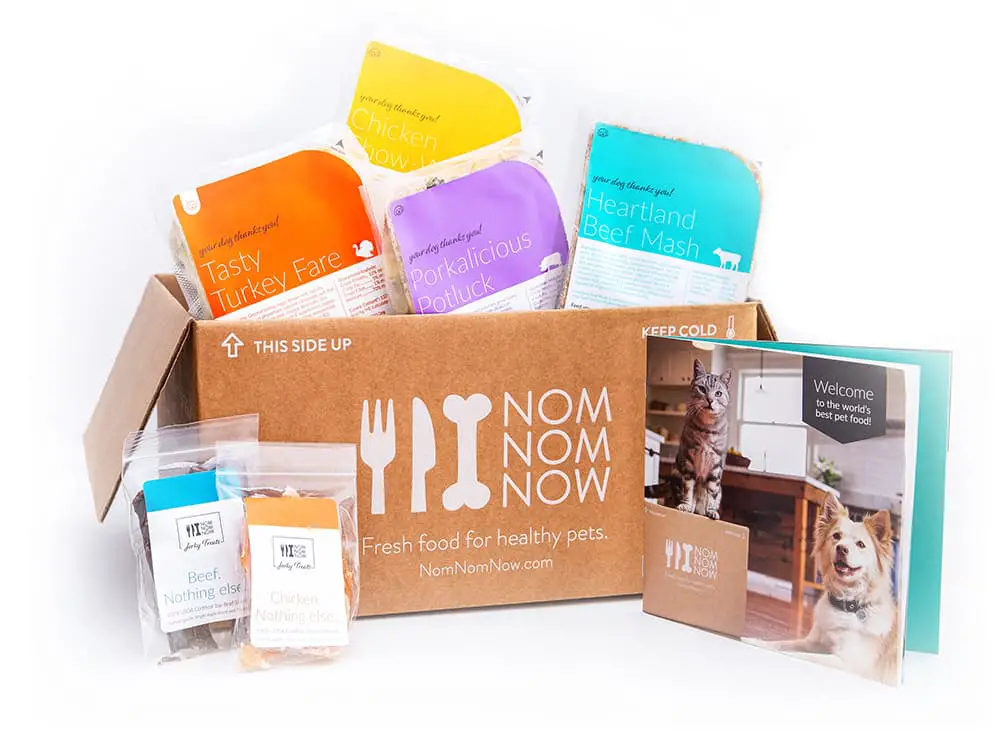
Nom Nom Now Dog Food
- Fresh, human-grade ingredients
- Near-perfect macronutrients
- Convenient delivery
Doggypedia rating: 5/5
Calories/100g: 119 kCal/100g
Sodium Content (Dry Matter Basis): 0.31%
First 5 Ingredients: Diced chicken, sweet potatoes, yellow squash, spinach, and sunflower oil.
Macronutrients (Dry-Matter Basis):
Protein: 37% minimum
Fat: 26.1% minimum
Carbs: 23.9% maximum
Best Low Sodium Wet Dog Food Grain Free
Placing first in the wet food category is NomNomNow’s Chicken Chow-Wow recipe. With an ingredient list formulated by a veterinary nutritionist, a fantastic macronutrient balance, a low sodium content, and an innovative brand ethos, this product definitely deserves its title as the best wet food.
NomNomNow isn’t your usual commercial dog food, in that you won’t find it on the shelves of any of the usual stores. Instead, ordering is done through their website, and then the food is delivered directly to your door. This is a great convenience, especially for pet parents who are on-the-go and don’t have time to be buying dog food every week.
NomNomNow offers four recipes, but the Chicken-Chow Wow one has the lowest sodium content by far. According to their website, which gives a full representative analysis of a sample of each of their recipes, it contains 0.31% sodium by dry matter basis. This percentage is great for dogs who need a mild to moderate sodium restriction to maintain their cardiac health (VVCS, 2018). Talk to your vet about what type of sodium restriction suits your pup best.
In terms of macronutrients, it’s very obvious that NomNomNow’s recipes are formulated with care. Chicken Chow-Wow contains 37% protein, 26.1% fat, and 23.9% carbohydrates. This ratio is very close to the ideal and hits all of the targets dictated by the AAFCO. There are foods on this list that contain a lower carbohydrate percentage, but given that the recipe is a grain free dog food and only contains healthy carb sources this isn’t a negative factor.
The ingredient list of Chicken Chow-Wow is an interesting one. The first ingredient is human-grade chicken, followed by sweet potatoes, which are a highly digestible form of energy. Other highlights include fish and sunflower oil, which are sources of omega-3 and omega-6 fatty acids respectively, and spinach, which is high in B vitamins.
Runner-up
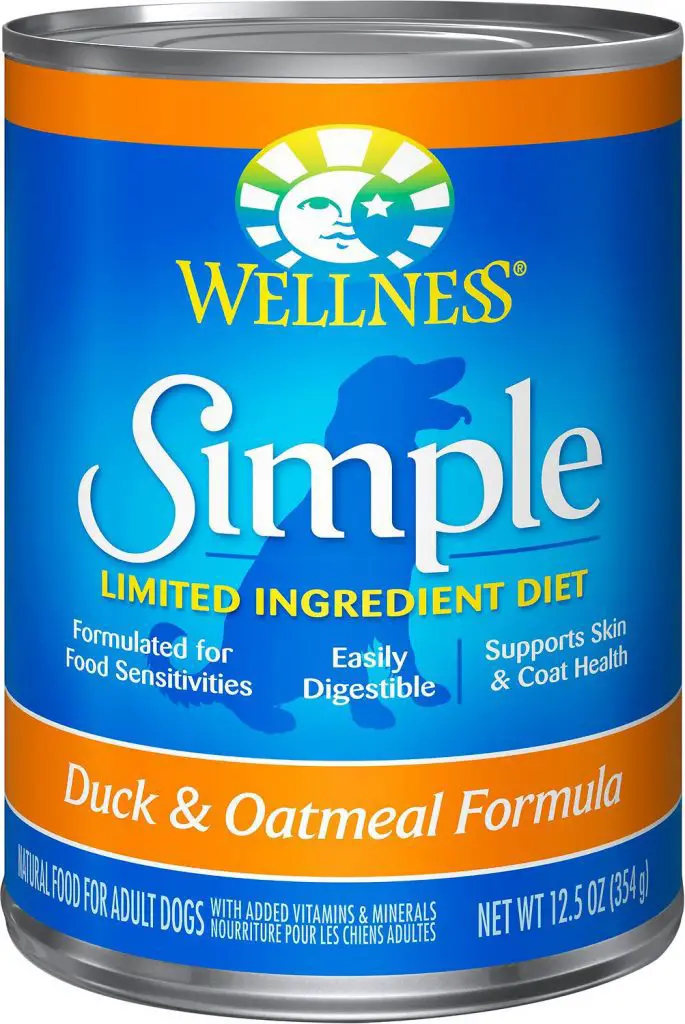
Wellness Simple Duck And Oatmeal
- Simple, clean ingredients
- Appropriate for dogs who need a limited ingredient diet
- Great macronutrients
Doggypedia rating: 4/5
Calories/100g: 135 kCal/100g
Sodium Content (Dry Matter Basis): 0.28%
First 5 Ingredients: Duck, Duck Broth, Oatmeal, Carrageenan, and Guar Gum.
Macronutrients (Dry-Matter Basis):
Protein: 36.4% minimum
Fat: 31.8% minimum
Carbs: 18.2% maximum
Good for low sodium diet for dogs
Most low sodium dog foods are chicken-based, but the second food in the wet food category breaks the mold. Wellness’ Simple Duck and Oatmeal recipe is a fantastic product, with a solid ingredient list and a good macronutrient balance.
This product is a limited ingredient dog food, which means that certain ingredients are excluded to make it appropriate for pups with certain food allergies or sensitivities.
The sodium content of this food is 0.28%, which is suitable for owners who need a moderate sodium restriction to maintain their dog’s health. Check with your vet to determine if this sodium content is suitable for your pup.
In terms of macronutrients, Wellness’ Simple Duck and Oatmeal has 36.4% protein, 31.8% fat, and 18.2% carbs. Like NomNomNow, these percentages all comply with the AAFCO standards. The majority of the carbohydrate content comes from oatmeal, which is a good source of fiber but doesn’t contain many other nutrients. While veggies would be preferable, this isn’t too much of an issue.
Aside from oatmeal and duck meat, the other ingredients in this product include flaxseed, which is a source of omega-3, chicory root extract, which contains the prebiotic fiber inulin, and a variety of different vitamin supplements. Again, it would be nice to see this list fleshed out with some veggies, but it isn’t essential.
Runner-up
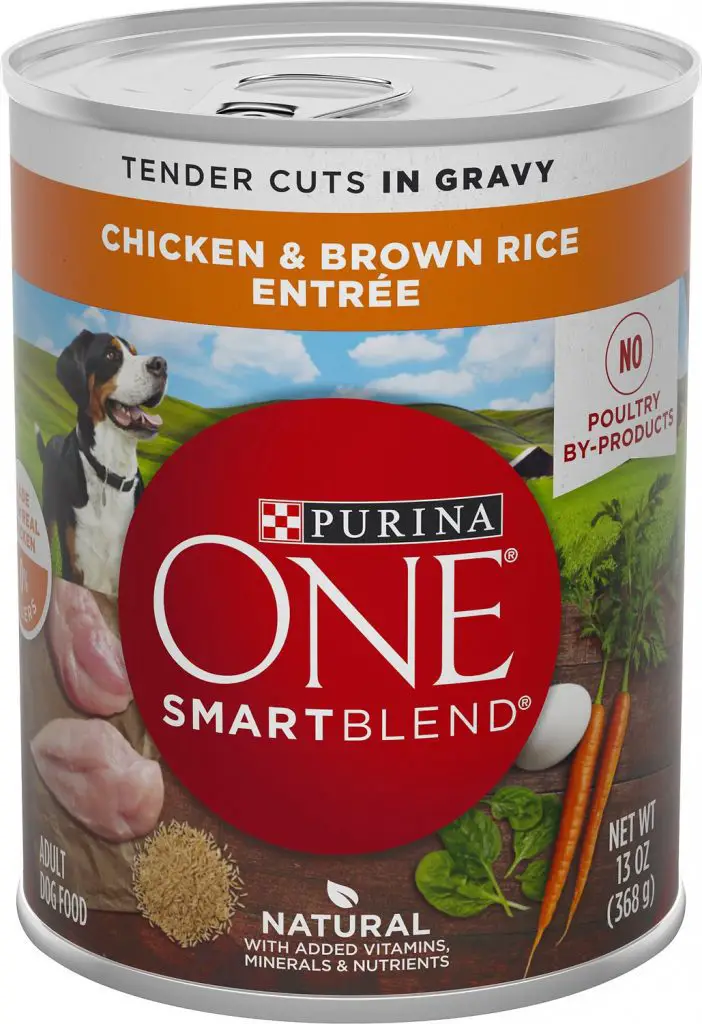
Purina ONE Chicken And Brown Rice
- More affordable than comparable products
- Includes wheat gluten and meat by-products
- 50% Protein
Doggypedia rating: 3/5
Calories/100g: 93 kCal/100g
Sodium Content (Dry Matter Basis): 0.25%
First 5 Ingredients: Chicken and Turkey Broth, Chicken, Liver, Wheat Gluten, and Meat By-Products.
Macronutrients (Dry-Matter Basis):
Protein: 50% minimum
Fat: 15% minimum
Carbs: 20% maximum
low sodium canned dog food
Purina’s ONE Chicken and Brown rice recipe certainly has some merits, which is why it earns a place on this list. However, it also has some significant downsides, which should be taken into account before you decide to purchase it for your pup.
This product has the lowest sodium content of the wet foods; 0.25%. This makes the food acceptable for pups who need a moderate sodium restriction to combat their health issues. To check if this level of sodium restriction is right for your pup, consult your vet.
In terms of macronutrients, Purina ONE does well. It has 50% protein, which is the highest of the wet foods on this list, 15% fat, and 20% carbohydrates. The major carb source is brown rice, which is a whole grain and a good source of fiber and various minerals.
The major downside to this food is the inclusion of wheat gluten and meat by-products in the recipe. The addition of wheat gluten is a method that many dog food companies use to artificially inflate the protein content of their food. While it does have protein in it, grain glutens are deficient in some of the essential amino acids that your pup needs to function.
Meat by-products are low-quality meat sources, and the fact that the ‘meat’ is unspecified means that it would be coming from any type of animal. These ingredients are definitely a blow to Purina’s otherwise acceptable ingredient list.
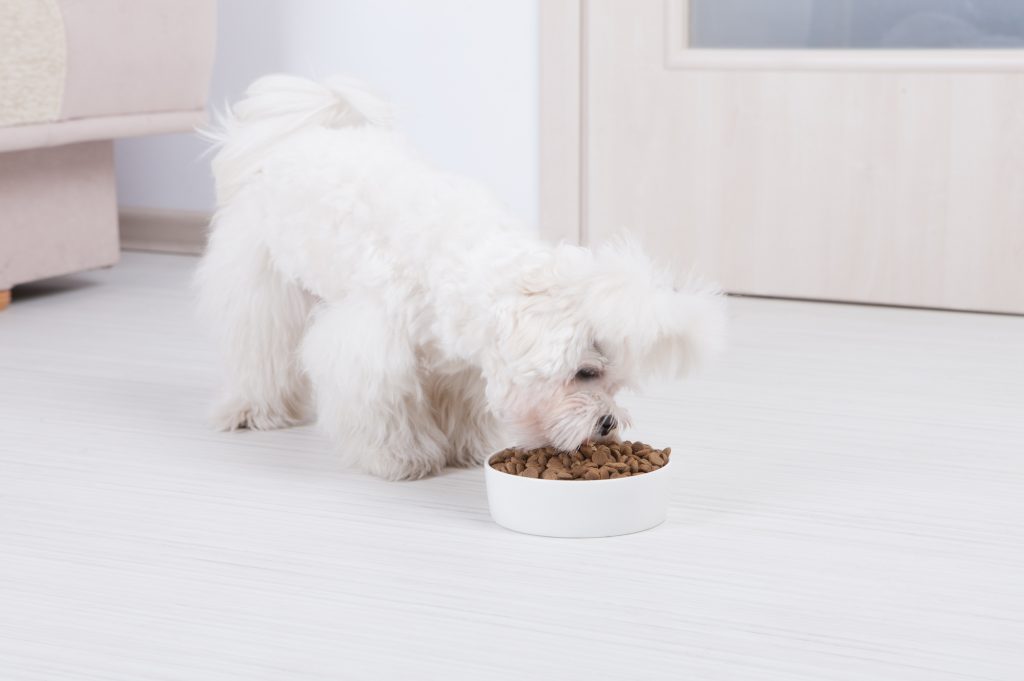
Best Low Sodium Dry Dog Foods
Our Pick
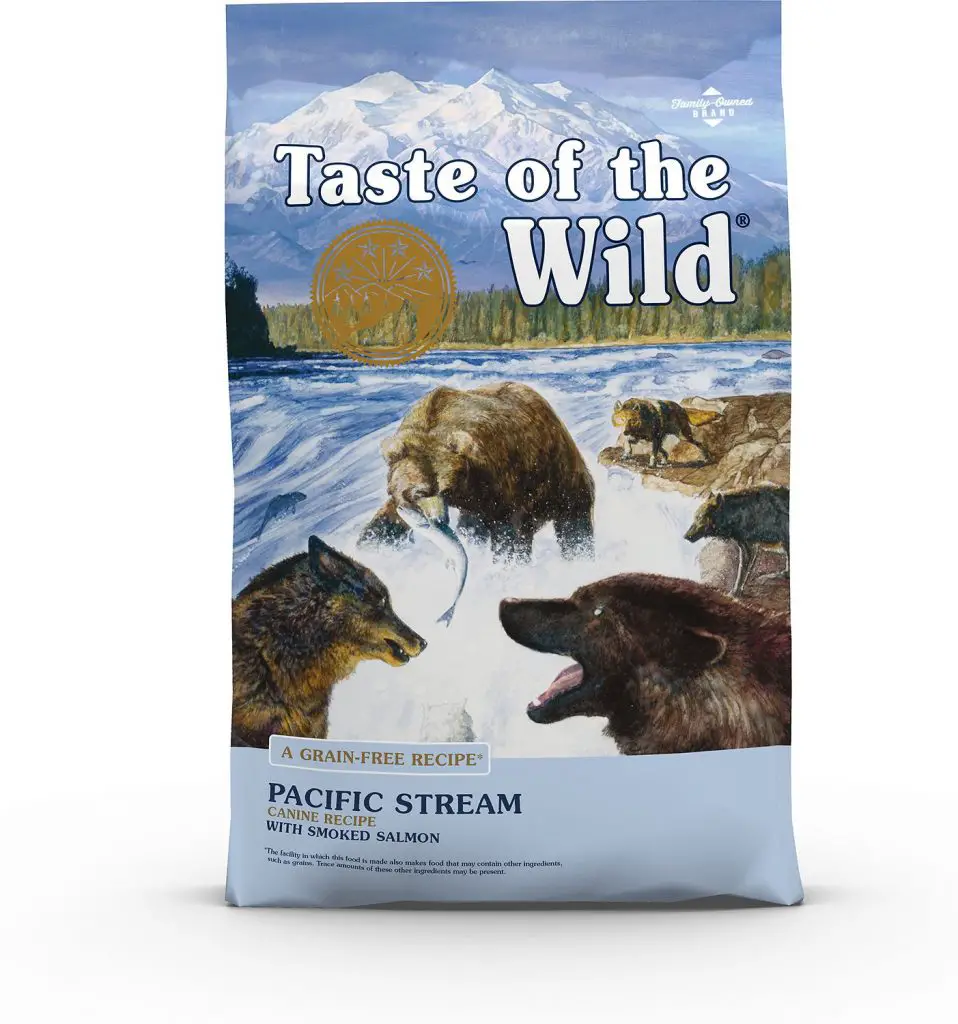
Taste Of The Wild Pacific Stream
- Great, unique ingredients
- Grain-free recipe
- Contains healthy Omega 3 fats
Doggypedia rating: 4.5/5
Calories/100g: 360 kCal/100g
Sodium Content (Dry Matter Basis): 0.27%
First 5 Ingredients: Chicken and Turkey Broth, Chicken, Liver, Wheat Gluten, and Meat By-Products.
Macronutrients (Dry-Matter Basis):
Protein: 27.8% minimum
Fat: 16.7% minimum
Carbs: 46.7% maximum
Best Low Salt Dry Food
Taking first place in the dry food section is Taste of the Wild’s Pacific Stream kibble. This food has a grain-free recipe and quality ingredients that align it with the canine ancestral diet, making it a great, natural food for pups who require a reduced sodium intake.
The sodium content of Taste of the Wild’s Pacific Stream recipe is 0.27%, which makes it suitable for owners who need moderate sodium restriction to maintain a healthy dog. Check with your vet to find out what level of sodium restriction your dog requires.
In terms of macronutrients, Taste of the Wild performs admirably. It contains 27.8% protein, 16.7% fat, and 46.7% carbohydrates. While the carb content may seem high, it’s important to recognise that this is a grain-free recipe, and the only carb sources are veggies. Sweet potatoes, which are a highly digestible source of energy, are the main carbohydrate source, followed by potatoes, peas, and lentils.
The animal protein sources include salmon, ocean fish meal and smoked salmon. These are all excellent sources of omega-3 fatty acids, which promote healthy skin and a healthy coat in dogs. Other ingredients of note include blueberries and raspberries, which are high in antioxidants, and yucca schidigera extract, which helps to control odor in pet waste.
Another unique benefit to this food is that Taste of the Wild’s dry food range includes a variety of different recipes. Their Pacific Stream variety has the lowest sodium content, but the High Prairie and Sierra Mountain varieties also have a low sodium content (0.28%). If your pup doesn’t enjoy the Pacific Stream recipe, or if you’d prefer to add some variety to your dog’s diet, then these recipes can be interchanged with little difference in nutritional value or sodium content.
Runner Up
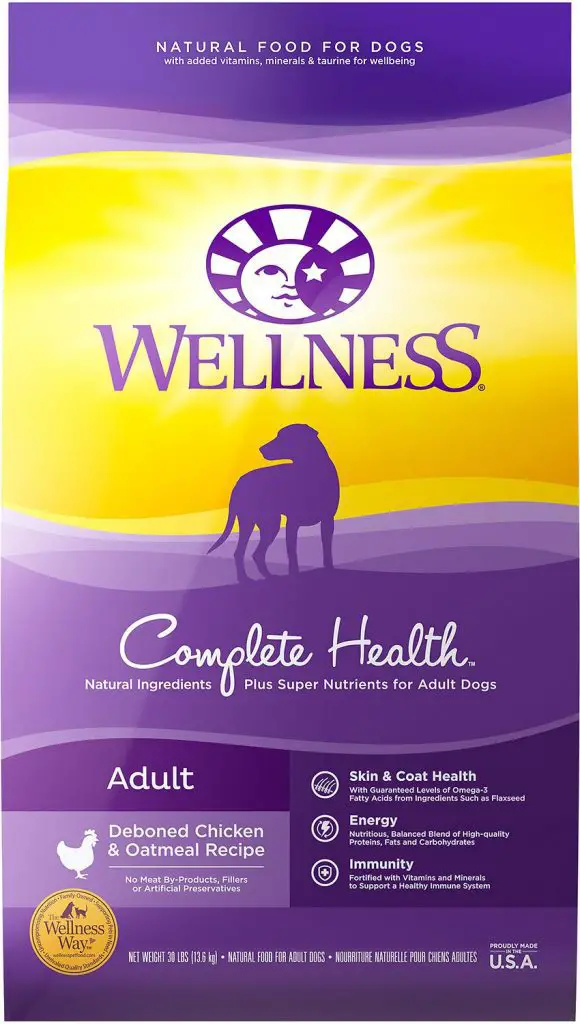
Wellness Complete Health Chicken And Oatmeal Recipe
- Great taste for picky eaters
- High carbohydrate content
- Simple, natural ingredients
Doggypedia rating: 4/5
Calories/100g: 362 kCal/100g
Sodium Content (Dry Matter Basis): 0.16%
First 5 Ingredients: Deboned Chicken, Chicken Meal, Oatmeal, Ground Barley, and Peas.
Macronutrients (Dry-Matter Basis):
Protein: 26.7% minimum
Fat: 13.3% minimum
Carbs: 51.1% maximum
dog food for congestive heart failure
Next on the list is Wellness’ Complete Health Chicken and Oatmeal recipe. With a very low sodium content, a simple and natural ingredient list and a solid macronutrient balance, this food is a great pick for dogs who need a significant reduction in their dietary sodium.
The sodium content of this food is just 0.16%, which makes it appropriate for dogs who need marked sodium restriction to accommodate their heart problems. Again, make sure to check with your vet to see if this level of sodium restriction is appropriate for your pup.
Wellness’ Chicken and Oatmeal recipe has a good protein at fat content, at 26.7% and 13.3% respectively. The carbohydrate content, however, is considerably higher than it should be. It sits at 51.1%, which is one of the highest of any of the foods on this list. While the carbohydrate sources are relatively healthy (oats contain omega-6 fatty acids and barley contains B vitamins), in an ideal dog food they’d be significantly reduced and more animal-based ingredients would be added.
Other ingredients to note in this product are ground flaxseed, which is a good source of omega-3, blueberries, which are rich in antioxidants, and apples, which are a great source of vitamin A and C and also assist in dental health. This combination of ingredients seems to translate into a great-tasting product, as owners largely report that even picky pups enjoy this food.
Runner Up
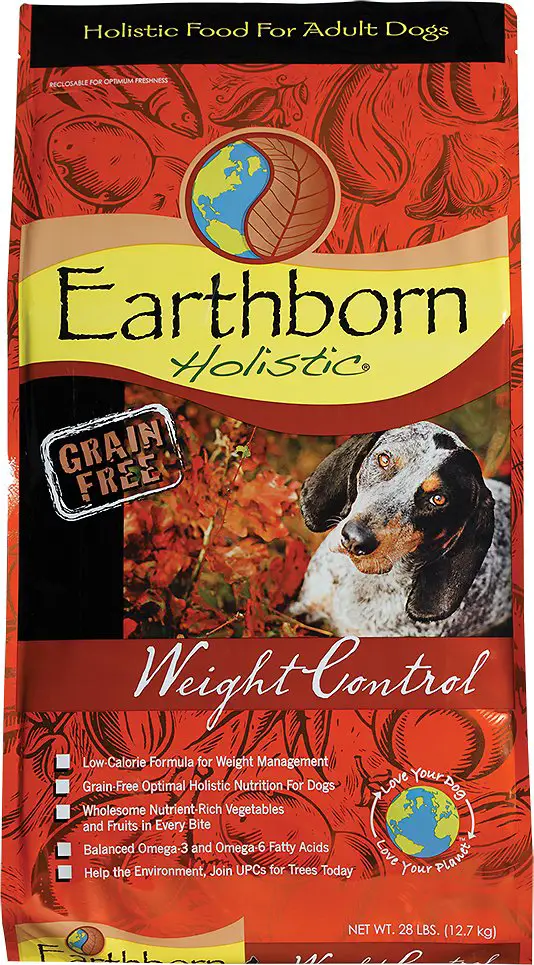
Earthborn Holistic Weight Control
- High fiber content to promote digestion
- Very high carbohydrate content
- Simple, natural ingredients
Doggypedia rating: 3.5/5
Calories/100g: 309 kCal/100g
Sodium Content (Dry Matter Basis): 0.16%
First 5 Ingredients: Chicken Meal, Peas, Tapioca, Pea Fiber, and Tomato Pomace.
Macronutrients (Dry-Matter Basis):
Protein: 27.8% minimum
Fat: 7.8% minimum
Carbs: 55.6% maximum
low salt dog food
Next on the list is Earthborn Holistic’s Weight Management food. With a high sodium restriction and high fiber content, this food performs well despite its shortcomings.
Again, the sodium content of this food is just 0.16%, which makes it appropriate for owners whose dog needs a marked sodium restriction. Make sure to check with your vet to see if this level of sodium restriction is appropriate for your pup.
In terms of macronutrients, Earthborn Holistic doesn’t do particularly well. While the protein content is 27.8%, the fat content is only 7.8%. This technically does meet the AAFCO standards, but not by very much. A low fat content indicates a reduced amount of animal-based ingredients used, which in general depreciates the quality of a food. Due to this, the carbohydrate content, 55.6%, is very high. The major source of carbs are peas, which don’t have any particular nutritional value.
A strong benefit to this food, however, is the high fiber content, which sits at 10% on a dry matter basis. For dogs who have digestive issues, this is a big plus, as fiber is great for colon health and promotes smooth movement in the gut. However, some dogs don’t tolerate high fiber foods well, so make sure to introduce this product to your pup slowly to prevent any upset stomachs.

Best Low Sodium Dog Foods for Puppies
Our Pick
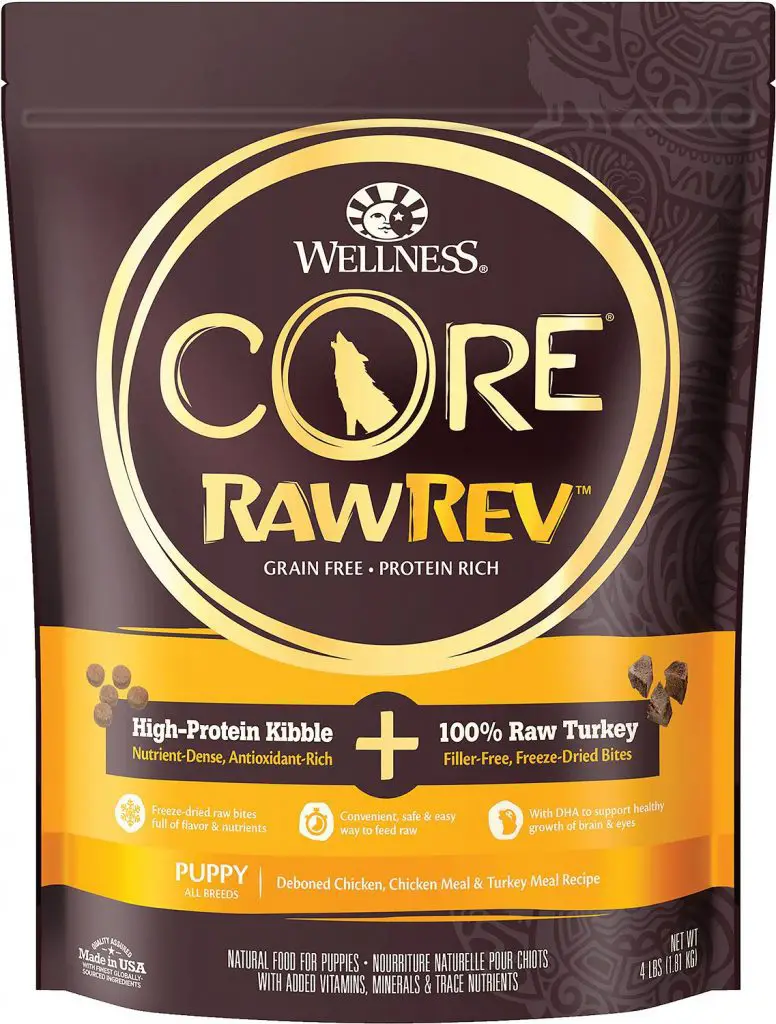
Wellness CORE RawRev Kibble
- Includes freeze-dried turkey pieces
- Excellent macronutrient profile
- Made for puppies
Doggypedia rating: 4.5/5
Calories/100g: 384 kCal/100g
Sodium Content (Dry Matter Basis): 0.39%
First 5 Ingredients: Deboned Chicken, Chicken Meal, Turkey Meal, Potatoes, and Peas.
Macronutrients (Dry-Matter Basis):
Protein: 42.2% minimum
Fat: 19.4% minimum
Carbs: 29.4% maximum
Claiming the title of the best puppy dry food is Wellness’ CORE RawRev kibble. With a fairly low sodium content that’s still appropriate for puppies, a recipe that heavily features freeze-dried meat, and a fantastic macronutrient balance, this is the perfect food for pups who require sodium restriction.
The real standout in this recipe is the raw, freeze-dried turkey pieces strewn throughout. Freeze-dried meats are generally healthier than their cooked counterparts, as they’re not prone to the nutrient loss that comes with high heat (Tran et. al., 2008). Additionally, these meaty pieces give the food a fantastic taste that even picky puppies are likely to enjoy.
The sodium content of this food is 0.39% on a dry matter basis. While there are no guidelines indicating what mild sodium restriction versus moderate sodium restriction looks like for puppies, the minimum acceptable sodium content for puppies is 0.3%, which means that this food is on the lower end of the spectrum.
In terms of macronutrients, Wellness’ RawRev hits every benchmark. It has 42.2% protein, 19.4% fat, and 29.4% carbohydrates. The major carb sources include potatoes and peas. While these veggies aren’t the most nutritious, they’re low enough in quantity to not warrant any concern. Other notable ingredients include fish oil, rosemary extract, and bananas.
Also Great
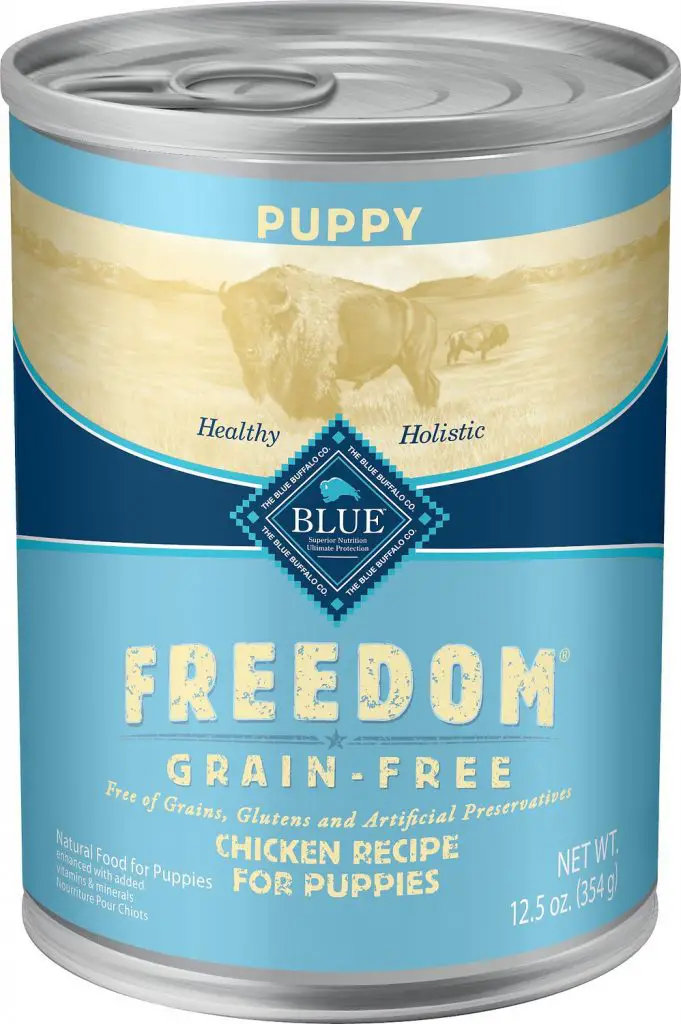
Blue Buffalo Freedom Chicken Recipe
- Includes healthy organ meats
- Good macronutrient balance
- Great ingredients
Doggypedia rating: 4/5
Calories/100g: 119 kCal/100g
Sodium Content (Dry Matter Basis): 0.45%
First 5 Ingredients: Chicken, Chicken Broth, Chicken Liver, Pea Flour, and Carrots.
Macronutrients (Dry-Matter Basis):
Protein: 40.9% minimum
Fat: 31.8% minimum
Carbs: 13.6% maximum
Taking second place in the puppy section is Blue Buffalo’s Freedom Chicken recipe. While this is a great product, with clean ingredients and a good macronutrient profile, there might be too much sodium for some puppies.
The sodium content of this food is 0.45% on a dry matter basis. This is significantly larger than the minimum requirement of 0.3% and means that puppies who need a significant sodium restriction may not suit this food. To be certain that this product is right for your precious pooch, make sure to consult with your vet.
The ingredient list of this food is solid, featuring real chicken as the first ingredient, followed by chicken broth and chicken liver. While your pup is growing it’s especially important that they’re getting enough nutrients, and organ meats are high in B vitamins, so this inclusion is certainly a plus.
The macronutrient balance of this food is good, with 40.9% protein, 31.8% fat, and 13.6% carbs. The main sources of carbohydrates are peas and carrots. Peas are high in fiber and carrots contain vitamin A, potassium, and are great for dental hygiene.
How Much Salt do Dogs Need?
Though it’s demonised by much of the healthy eating community, sodium is actually an essential mineral. It’s used by the body to initiate action potentials, which are the electrical pulses that allow nerves to communicate with each other. It’s also essential for the movement of water around the body, which is what causes its link to blood pressure (Corman, Roinel and de Rouffignac, 1981).
The Association of American Feed Control Officials is the organisation that dictates the minimum acceptable standards for nutrients that all dog food products sold in the U.S. must contain. According to their 2014 report, the minimum amount of sodium that an adult dog food must contain is 0.08% by dry matter, while the minimum amount required for puppies is 0.3% (AAFCO, 2014).
Why Feed Your Dog Low Sodium Food ?
If your pooch doesn’t have a specific health condition that is affected by dietary sodium, choosing a low-sodium food won’t be beneficial, so it’s important to understand if your dog actually requires low-sodium or not.
As mentioned before, there’s little to no evidence that indicates that restricting sodium intake is a good way to treat hypertension in dogs (Acierno et. al., 2018). However, there are some other good reasons to feed your pup a low-sodium diet.
The primary reason that your vet may recommend restricting salt intake is due to congestive heart failure (CHF). This disease, which causes persistent coughing and difficulty breathing, is made worse by excess sodium intake. According to the VCA Animal Hospital, the sodium intake of adult dogs with congestive heart failure should be restricted to between 0.08% to 0.25% (Weir and Ward, 2019).
Aside from heart disease, there are a few other health problems that your dog may have that would encourage your vet to recommend a low-sodium food. Dogs with kidney disease can benefit from a low sodium food, as high blood pressure can worsen kidney damage (Fascetti and Delaney, 2019). Dogs with liver disease may also be recommended a low sodium diet. This is because certain types of liver disease can cause ascites, which is a buildup of fluid in the abdomen, and restricting sodium intake can help to prevent or ease this (S.A. Center, 1998).
How we Chose and Ranked the Best Low Sodium Dog Foods
The most important factor that determines whether a dog food is suitable or not is its macronutrient profile. This refers to the balance of protein, fat, and carbohydrates present in the food. Protein and fat are particularly important, as they’re essential nutrients that fuel a range of important functions for your pup. Because of their importance, the AAFCO publishes specific guidelines that all dog food companies in the U.S. must follow (AAFCO, 2014). For adult dogs, these include:
- A protein content of over 18%
- A crude fat content of over 5.5%
Several of the foods on this list are designed for puppies, who have a different set of nutritional requirements to adult dogs as they’re still growing. AAFCO dictates these to be the following:
- A protein content over 22.5%
- A fat content over 8.5%
- A minimum of 1.2% calcium
The third macronutrient, carbohydrates, aren’t an essential part of the canine diet. While carb sources like whole grains and veggies provide a great source of vitamins and fiber, the carbs themselves simply serve as a source of energy (Roberts et. al., 2017). To cut costs, many dog food companies will pack their products full of non-nutritious grain by-products and fillers. Foods with a lower percentage of carbohydrates are usually higher quality because they don’t contain these unhealthy fillers and have more room for meat ingredients. Based on this knowledge, we’ve developed the following guideline:
- A carbohydrate content under 30%, with preference given to healthy and digestible carbohydrate sources
Medical Conditions that Require Low-Sodium Dog Food
The major health condition that requires a low-sodium diet is congestive heart failure (source). This is a serious, life-threatening condition. It is not curable. However, the dog’s lifespan can be greatly increased and the symptoms of the disease can be managed in a variety of ways. One of these ways is through dietary changes, which is where a low-sodium dog food may be helpful as sodium can increase the symptoms and severity of the disorder. Most veterinarians will recommend a low-sodium dog food to animals with congestive heart failure. They will need to stay on this food throughout the rest of their life.
Some liver and kidney conditions might also call for a low-sodium dog food. This may be helpful because it gives the liver and kidneys more of a break, since they won’t need to filter out as much sodium as they would otherwise. Kidneys in particular can be further bothered by high amounts of sodium, which is why a low-sodium diet may be necessary.
Read More Dog Food Reviews: Best Kangaroo Dog Food and Best High Calorie Dog Food
SOURCES:
- Sodium restriction for hypertension: Acierno, M., Brown, S., Coleman, A., Jepson, R., Papich, M., Stepien, R. and Syme, H. (2018). ACVIM consensus statement: Guidelines for the identification, evaluation, and management of systemic hypertension in dogs and cats. Journal of Veterinary Internal Medicine, 32(6), pp.1803-1822.
- Sodium restriction for heart failure: Rush, J., Freeman, L., Brown, D., Brewer, B., Ross, J. and Markwell, P. (2000). Clinical, Echocardiographic, and Neurohormonal Effects of a Sodium-Restricted Diet in Dogs with Heart Failure. Journal of Veterinary Internal Medicine, 14(5), pp.513-520.
- Sodium and water movement: Corman, B., Roinel, N. and de Rouffignac, C. (1981). Dependence of water movement on sodium transport in kidney proximal tubule: A microperfusion study substituting lithium for sodium. The Journal of Membrane Biology, 62(1-2), pp.105-111.
- AAFCO sodium, protein, and fat guidelines: The 2014 AAFCO Dog Food Nutrient Profile for Growth and Reproduction. (2019). [ebook] AAFCO. Available at: https://www.aafco.org/Portals/0/SiteContent/Regulatory/Committees/Pet-Food/Reports/Pet_Food_Report_2013_Midyear-Proposed_Revisions_to_AAFCO_Nutrient_Profiles.pdf [Accessed 10 Nov. 2020].
- Symptoms of CHF in dogs: Weir, M. and Ward, E. (2019). Congestive Heart Failure in Dogs. [online] vca_corporate. Available at: https://vcahospitals.com/know-your-pet/congestive-heart-failure-in-dogs [Accessed 10 Jan. 2020].
- Low sodium diet for kidney disease: Fascetti, A. and Delaney, S. (2019). Nutritional Management of Chronic Renal Disease. [online] School of Veterinary Medicine. Available at: https://www.vetmed.ucdavis.edu/hospital/animal-health-topics/chronic-renal-disease [Accessed 11 Jan. 2020].
- Low sodium diet for liver disease: Center, S. (1998). Nutritional Support for Dogs and Cats with Hepatobiliary Disease. The Journal of Nutrition, 128(12), pp.2733S-2746S.
- Carbohydrates in dog food: Roberts, M., Bermingham, E., Cave, N., Young, W., McKenzie, C. and Thomas, D. (2017). Macronutrient intake of dogs, self-selecting diets varying in composition offered ad libitum. Journal of Animal Physiology and Animal Nutrition, [online] 102(2), pp.568-575. Available at: https://onlinelibrary.wiley.com/doi/full/10.1111/jpn.12794 [Accessed Jan 10. 2020].
- Levels of sodium restriction: Vermontveterinarycardiology.com. (2018). Feeding the Cardiac Patient. [online] Available at: http://www.vermontveterinarycardiology.com/index.php/for-clients/feeding-the-cardiac-patient [Accessed 9 Jan. 2020].
- Nutrient loss during cooking: Tran, Q., Hendriks, W. and van der Poel, A. (2008). Effects of extrusion processing on nutrients in dry pet food. Journal of the Science of Food and Agriculture, 88(9), pp.1487-1493.
